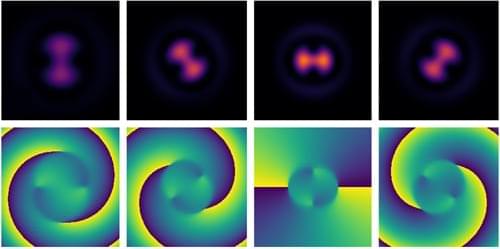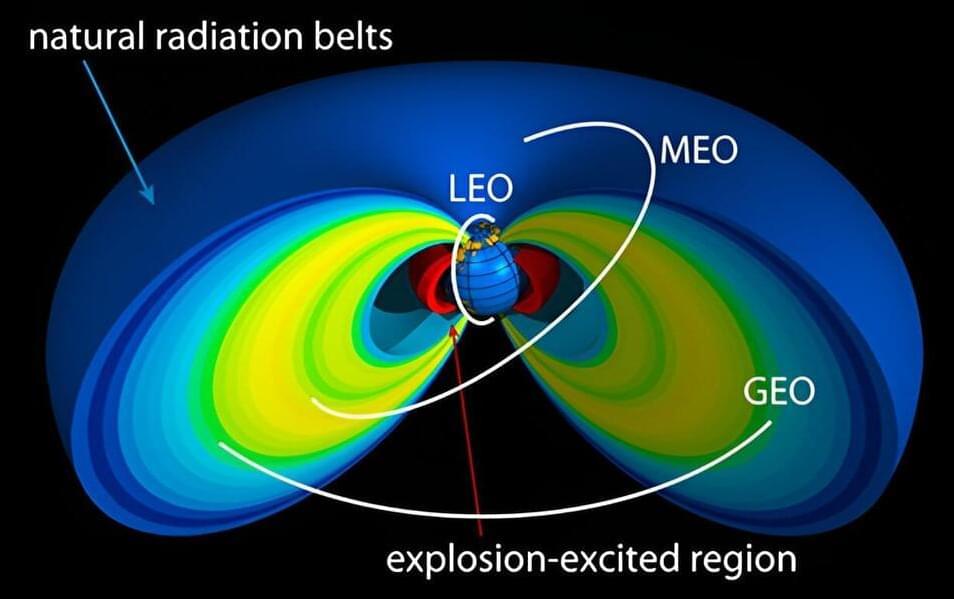Researchers have developed a quantum gas microscope that can pinpoint the horizontal and vertical positions of atoms arranged in a lattice.



Physicists successfully measure gravity in the quantum world, detecting weak gravitational pull on a tiny particle with a new technique that uses levitating magnets, putting scientists closer to solving mysteries of the universe.
Scientists are a step closer to unraveling the mysterious forces of the universe after working out how to measure gravity on a microscopic level.
Experts have never fully understood how the force discovered by Isaac Newton works in the tiny quantum world.

Correcting 50-year-old errors in the math used to understand how electromagnetic waves scatter electrons trapped in Earth’s magnetic fields will lead to better protection for technology in space.
“The discovery of these errors will help scientists improve their models of artificial radiation belts produced by high-altitude nuclear explosions and how an event like that would impact our space technology,” said Greg Cunningham, a space scientist at Los Alamos National Laboratory. “This allows us to make better predictions of what that threat could be and the efficacy of radiation belt remediation strategies.”
Heliophysics models are important tools researchers use to understand phenomena around the Earth, such as how electrons can become trapped in the near-Earth space environment and damage electronics on space assets, or how Earth’s magnetic field shields us from both cosmic rays and particles in solar wind.

Harvard scientists have made a significant advance in high-pressure physics by creating a tool that directly images superconducting materials under extreme conditions, facilitating new discoveries in the field of superconducting hydrides.
Hydrogen (like many of us) acts weird under pressure. Theory predicts that when crushed by the weight of more than a million times our atmosphere, this light, abundant, normally gaseous element first becomes a metal, and even more strangely, a superconductor – a material that conducts electricity with no resistance.
Scientists have been eager to understand and eventually harness superconducting hydrogen-rich compounds, called hydrides, for practical applications – from levitating trains to particle detectors. But studying the behavior of these and other materials under enormous, sustained pressures is anything but practical, and accurately measuring those behaviors ranges somewhere between a nightmare and impossible.

For more than a decade it has been possible for physicists to accurately measure the location of individual atoms to a precision smaller than one-thousandth of a millimeter using a special type of microscope. However, this method has so far only provided the x and y coordinates. Information on the vertical position of the atom is lacking.
A new method has now been developed that can determine all three spatial coordinates of an atom with one single image. This method—developed by the University of Bonn and University of Bristol—is based on an ingenious physical principle. The study is published in the journal Physical Review A.
Anyone who has used a microscope in a biology class to study a plant cell will probably be able to recall a similar situation. It is easy to tell that a certain chloroplast is located above and to the right of the nucleus.

If two points were ripped apart faster than light, they would no longer interact through any force of physics. Whereas a constant dark energy would leave behind already-intact objects, like clusters of galaxies, phantom energy could tear them apart. In a finite amount of time, billions of years from now, clusters would tear apart, followed by ever-smaller objects. Even atomic and nuclear bonds would not withstand the onslaught.
Eventually, space itself would dissolve in an event known as the Big Rip. Any two points, no matter how close, would be ripped infinitely far away from each other. The very structure of space-time, the causal foundations that make our universe work, would no longer behave. The universe would just break down.
However, luckily, most physicists do not believe this scenario can actually happen. For one, it’s unclear how this process of ripping interacts with the other laws of physics. For example, quarks cannot be torn apart — when you attempt to do so, you need so much energy that new quarks materialize out of the vacuum. So ripping apart quarks just might lead to other, interesting interactions.

Spintronics is a field that deals with electronics that exploit the intrinsic spin of electrons and their associated magnetic moment for applications such as quantum computing and memory storage devices. Owing to its spin and magnetism exhibited in its insulator-metal phase transition, the strongly correlated electron systems of nickel oxide (NiO) have been thoroughly explored for more than eight decades. Interest in its unique antiferromagnetic (AF) and spin properties has seen a revival lately since NiO is a potential material for ultrafast spintronics devices.
Despite this rise in popularity, exploration of its surface magnetic properties using the low-energy electron diffraction (LEED) technique has not received much attention since the 1970s. To review the understanding of the surface properties, Professor Masamitsu Hoshino and Emeritus Professor Hiroshi Tanaka, both from the Department of Physics at Sophia University, Japan, revisited the surface LEED crystallography of NiO.
The results of their quantitative experimental study investigating the coherent exchange scattering in Ni2+ ions in AF single crystal NiO were reported in The European Physical Journal D.
The story of how life started on Earth is one that scientists are eager to learn. Researchers may have uncovered an important detail in the plot of chapter one: an explanation of how bubbles of fat came to form the membranes of the very first cells.
A key part of the new findings, made by a team from The Scripps Research Institute in California, is that a chemical process called phosphorylation may have happened earlier than previously thought.
This process adds groups of atoms that include phosphorus to a molecule, bringing extra functions with it – functions that can turn spherical collections of fats called protocells into more advanced versions of themselves, able to be more versatile, stable, and chemically active.

Quantum traffic laws applied to the 3D streetscape of a specific kind of crystal can put the brakes on electron rush hour.
In a search for novel materials that can contain bizarre new states of matter, physicists from Rice University in the US led an experiment that forced free-roaming electrons to stay in place.
While the phenomenon has been seen in materials where electrons are constrained to just two dimensions, this is the first time it’s been observed in a three-dimensional crystal metal lattice, known as a pyrochlore. The technique gives researchers a new tool for studying the less conventional activities of plucky, charge-carrying particles.

Condensed matter systems and photonic technologies are regularly used by researchers to create microscale platforms that can simulate the complex dynamics of many interacting quantum particles in a more accessible setting. Some examples include ultracold atomic ensembles in optical lattices, superconducting arrays, and photonic crystals and waveguides. In 2006 a new platform emerged with the demonstration of macroscopically coherent quantum fluids of exciton-polaritons to explore many-body quantum phenomena through optical techniques.
When a piece semiconductor is placed between two mirrors—an optical microresonator—the electronic excitations within can become strongly influenced by photons trapped between the mirrors. The resulting new bosonic quantum particles, known as exciton-polaritons (or polaritons for short), can under the right circumstances undergo a phase transition into a nonequilibrium Bose-Einstein condensate and form a macroscopic quantum fluid or a droplet of light.
Quantum fluids of polaritons have many salient properties, one being that they are optically configurable and readable, permitting easy measurements of the polariton dynamics. This is what makes them so advantageous to simulate many-body physics.